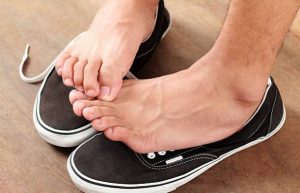 Athlete’s foot or tinea pedis are the common names used for the fungal infection that affects the skin around the feet.
Athlete’s foot or tinea pedis are the common names used for the fungal infection that affects the skin around the feet.
This condition is common among athletes, but it can affect anyone. In some cases, the condition can be really serious, especially when you have a weak immune system or diabetes. However, if you suspect that you may have developed fungus infection on the feet, you must consult with your health professional immediately.
What are the Causes?
The growth of fungus on your feet can be caused due to a number of reasons. If someone is already infected and you come into contact with that person by either touching him directly or touching surfaces that have been contaminated with the fungus, then you may be at a risk too. Feet fungus which is also known as tinea fungus thrives in moist and warm environment. Some of the places where they commonly grow include swimming pools, floors of locker rooms and showers.
Risk Factors
It is possible for just anyone to get a fungal infection, but certain things, habits, and behaviors can put you at a greater risk. You can get athlete’s foot if you do or have any of the following:
- Visit public showers, swimming pools and locker rooms barefoot
- Share towels and socks with an infected person
- Have sweaty feet
- Wear shoes which make your feet sweat
- Wear shoes which have closed toes
- Suffer from nail or skin injury on your feet
Symptoms To Look Out For
A person who is infected with athlete’s foot can experience any of these symptoms.
- Burning, stinging or itching sensation between the toes and soles
- Blisters
- Dry skin
- Peeling or cracking of skin
- Crumbly toenails
- Raw skin
Treatments of Fungal Infection On The Feet
 There are a number of ways to treat fungus on your feet. Depending on the severity of the condition, you can take over the counter medications or prescribed medications. Over the counter medications include topical creams that you can apply to the affected area. However, if the problem persists, you can seek help from a medical professional who will then prescribe stronger anti-fungal creams and oral medications.
There are a number of ways to treat fungus on your feet. Depending on the severity of the condition, you can take over the counter medications or prescribed medications. Over the counter medications include topical creams that you can apply to the affected area. However, if the problem persists, you can seek help from a medical professional who will then prescribe stronger anti-fungal creams and oral medications.
A number of home remedies can also be used to treat foot fungus. Health professional suggest that anyone who is suffering from athlete’s foot must soak their feet in salt water and vinegar solution. Diluted vinegar when added to salt water solution can help dry the blister and provide relief from itching.
Athlete’s foot can become severe if it is left untreated. The risk of infection spreading from toe to toe increases if treatment is not received in a timely manner. In some cases, the infection can spread from the feet to the hands as well. This is possible especially when the patient does not wash their hands after touching the affected area. Even if they touch other parts of their body after scratching the affected area, it is possible for the infection to spread. This is the reason it is essential to treat the condition as soon as symptoms arise.
How To Prevent Foot Fungus
Prevention is always better than cure and it is very much possible to prevent fungal infection on the foot. Here are some of the steps you can take towards preventing foot fungus.
- Use antifungal powder on your feet if you suspect you may develop athlete’s foot or if you are required to wear closed-toe shoes or socks all the time.
- Use soap and water to wash your feet every day and always make sure that your feet are thoroughly dried, including areas in between the toes.
- Avoid sharing towels and socks with others, especially people who have athlete’s foot.
- Do not walk around locker rooms, swimming pools and public showers barefoot.
- Choose socks which are made from cotton, wool or other breathable fabrics.
- Allow your feet to get some air when you are at home.
- If your feet get sweaty easily, keep two pairs of shoes for work and alternate between the pairs so one can dry out when you are using the other.



